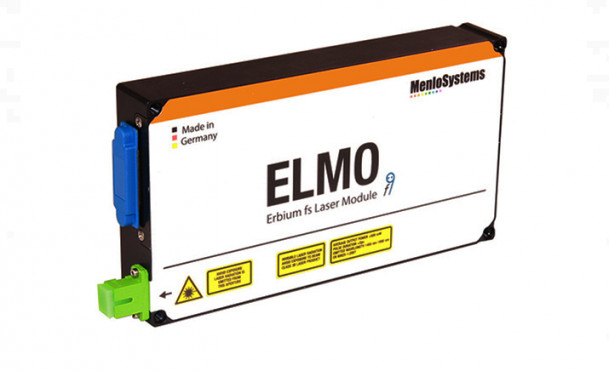Menlo Systems product:
Original publication:
Nature Photonics, Vol. 12, June 2018, 330–335, doi.org/10.1038/s41566-018-0144-1
High-Resolution Sensor for Molecules
A team in the Laboratory of Photonics and Quantum Measurements (LPQM) at the École Polytechnique Fédérale de Lausanne in Switzerland recently described a novel and particularly effective method for generating mid-infrared light for use in molecular spectroscopy. The researchers employed Menlo’s erbium-fiber-based femtosecond laser (ELMO), which emits trains of femtosecond pulses with a wavelength of 1.55 micrometers (µm), as the pump for their new, non-linear light source.
For the spectroscopic identification of chemicals, a source of broadband radiation in the mid-infrared range between 1.4 and 20 µm is required. Interaction with light in this spectral region excites the chemical bonds in molecules to vibrate and absorb photons at highly specific wavelengths. The spectrum of the transmitted light therefore provides a characteristic fingerprint which is unique for each molecular species.
Broadband optical frequency combs therefore constitute an ideal tool for molecular spectroscopy. Frequency combs are laser sources whose spectra are made up of discrete lines that are equidistant from each other in frequency.
Image Courtesy: Laboratory of Photonics and Quantum Measurements
FIG. 1. Principle of mid-IR frequency comb based on dispersive wave generation. (a) Experimental setup in which the pump is a commercial erbium-fiber based femtosecond pulsed laser centered at 1.55 µm (ELMO, Menlo System GmbH). (b) Scanning electron microscope (SEM) pictures of the cross sections of two classes of Si3N4 waveguides fabricated using the photonic Damascene process.
However, up until recently, the production of frequency combs in the mid-infrared region has been a difficult undertaking. This is because very few of the materials that serve as waveguides are suitable for the generation of mid-infrared frequency combs. To convert the 1.55-µm pump pulses emitted by the Menlo laser into broadband mid-infrared light, the researchers at the LPQM used a carefully engineered waveguide made of silicon nitrite (Si3N4). The resulting longer wavelengths were then used to generate the desired frequency comb covering the mid-infrared range from 2.5 to 4 µm. The team suggests that this technique could serve as the basis for the realization of compact dual-comb spectroscopy systems.
Dual-comb instruments allow one to repeatedly generate two frequency combs covering the same set of wavelengths, but differing slightly in their repetition rate. One of the combs is used to measure absorption spectra by passing the beam through a gas cell containing the sample. The transmitted comb is then combined with the second, reference comb, and the resulting spectrum is time-resolved with the aid of a photodiode. The difference in the repetition rates gives rise to an interference spectrum that lies in the radio frequency (RF) range. Crucially, this difference spectrum includes the information present in the optical spectrum that encodes the molecular absorption data, which can be recovered by comparison with the reference comb.
In their paper in Nature Photonics, the authors assume that the combs produced with their new method are capable of reliably detecting molecules. By opening a route to compact and highly efficient dual-comb spectrometers in the mid-infrared range, the new method should also make it possible to perform highly sensitive analyses of molecules in the gas phase.
Original publication:
Hairun Guo, Clemens Herkommer, Adrien Billat, Davide Grassani, Chuankun Zhang, Martin H. P. Pfeiffer, Wenle Weng, Camille-Sophie Brès and Tobias J. Kippenberg: Mid-infrared frequency comb via coherent dispersive wave generation in silicon nitride nanophotonic waveguides Nature Photonics, Vol. 12, June 2018, 330–335, doi.org/10.1038/s41566-018-0144-1
